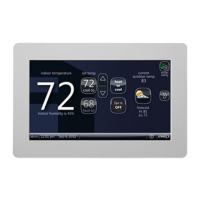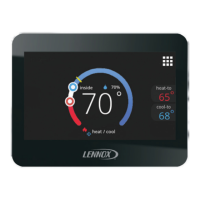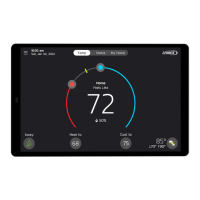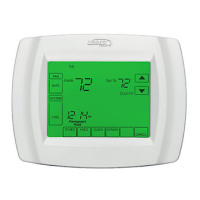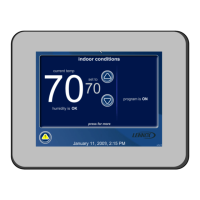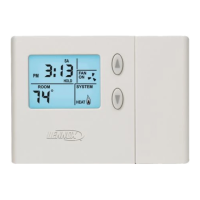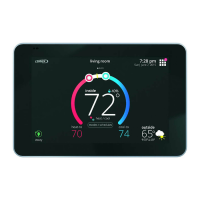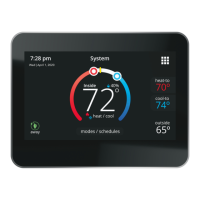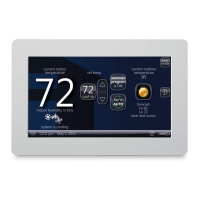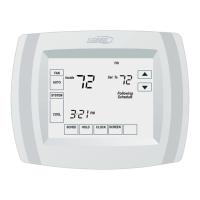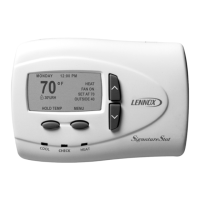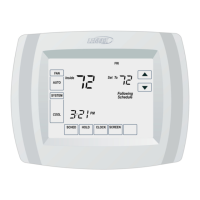44
Advanced Dehumidication Descriptions
See table 1 for detail information concerning system operations when using
Normal, Max or Climate IQ settings.
Table 16. Dehumidication Control Modes of Operations
Mode of
Operation
Option Description
Dehumidication
Only
Normal
Both Staged and Variable Capacity Outdoor Units:
Dehumidies while servicing a cooling demand and will
not over cool. The overcooling slider is hidden from the
user. Variable capacity units use the “comfort” table to run
the system, regardless of the presence of a discharge air
temperature sensor (DATS).
Max
Staged Outdoor Unit:
If at the start or during a cooling call, the humidity is above
the relative humidity set point then the unit dehumidies
during the cooling demand. If at the time the cooling
call terminates, the humidity demand is not satised,
overcooling will occur up to the overcooling slider setting
in an attempt to satisfy the dehumidication demand.
Once the room temperature reaches the over cooling set
point. If the system still has a dehumidication demand,
the system keeps using the over cooling set point as its
operating cooling set point (will not wait for the temperature
to rise to the normal cooling set point to run again) until the
dehumidication demand is satised
Variable Capacity Outdoor Unit:
These units work as like staged units and if a discharge air
temperature sensor (DATS) sensor is installed, the DAT PI
setting is used to control the compressor speed to maintain
a cold coil for optimized dehumidication. If a DATS is not
installed, the system runs using the outdoor unit’s “comfort”
tables during dehumidication.
Dehumidication
Only
Available
only with
Max and
Climate IQ
(Auto)
Staged Outdoor Unit:
At the end of a cooling call, if the humidity is above the set
point by a certain amount (Basic to Precision Threshold
parameter), then overcooling to the overcooling slider
setting occurs to satisfy the dehumidication demand.
Once the room temperature reaches the overcooling set
point, if the system still has a dehumidication demand,
the system keeps using the over cooling set point as its
operating cooling set point (will not wait for the temperature
to rise to the normal cooling set point to run again) until the
dehumidication demand is satised.
Table 16. Dehumidication Control Modes of Operations
Mode of
Operation
Option Description
Dehumidication
Only
Available
only with
Max and
Climate IQ
(Auto)
Variable Capacity Outdoor Unit:
If at the start or during a cooling call, the humidity level is
below the relative humidity set point by more than 10%,
then the mode becomes “Dry” such that the blower CFM is
increased to the “Dry” table setting.
• If a cooling call starts with the humidity level below the
relative humidity setpoint, or if during a cooling call, the
humidity level is between the dehumidify off relative
humidity point and the relative humidity set point -10,
then standard cooling runs to satisfy the cooling demand,
without any added dehumidication.
• If at the start or during a cooling call, the humidity
is above the relative humidity set point then the unit
dehumidies during the cooling demand. If at the time the
cooling call terminates, the humidity is above the Basic to
Precision Threshold then overcooling will occur up to the
slider setting in an attempt to satisfy the dehumidication
demand. Once the room temperature reaches the over
cooling set point, if the system still has a dehumidication
demand, the system keeps using the over cooling set
point as its operating cooling set point (does not wait for
the temperature to rise to the normal cooling set point to
run again) until the dehumidication demand is satised.
• The Basic to Precision Threshold is a parameter with the
following properties: Denition: Relative humidity amount
above the relative humidity set point where over cooling
will occur to dehumidify. Default: 4, Min: 0, Max: 10, Inc: 1
• Variable capacity units use the “comfort” table to run the
system, regardless of the presence of a DATS.
0°F
0°F
4°F
2°F
48%
60%
40%
1 Variable capacity outdoor units are XC20, XP20, XC25 and XP25. NOTE - The above
information is applicable only for non-zoning systems, in addition to thermostat using
rmware version 3.15 or later. There is no dehumidication capability in zoning systems.
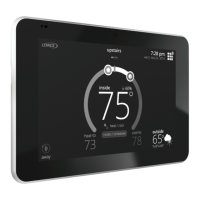
